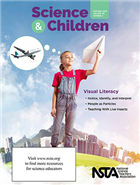First week back resources
By Peggy Ashbrook
Posted on 2018-12-23
 When you have a moment to plan for teaching in January, reach for the 2018 November/December issue of Science and Children for inspiration. With a focus on visual literacy the activities discussed in the columns and articles promote helping children learn from and use images and models to understand science concepts.
When you have a moment to plan for teaching in January, reach for the 2018 November/December issue of Science and Children for inspiration. With a focus on visual literacy the activities discussed in the columns and articles promote helping children learn from and use images and models to understand science concepts.
In The Early Years column, “Analyzing Media Representations of Animals,” I wrote up an activity using guidance from the National Association for Media Literacy Education (NAMLE) to analyze, evaluate, and create media. Many children’s books show images of animals that are not at life size, either to fit on the page or for convenience of design. If children have seen the animals they may be able to understand that the image is not at life-size, but if the animals are unknown, children can’t know what the actual size is. Engaging children in exploring how images accurately represent size or are possibly misleading, perhaps showing animals such as mice and horses at the same size, is part of teaching media literacy. Helping children create their own illustrations and photos of animals develops their understanding of how others use images.
Can one of our senses fool another one? The Poetry of Science column, “Visual Poetry,” presents a poem, and science activity, and internet resources for additional support!
The Engineering Encounters column, “Bears on a Boat Plus,” is a visit into a second-grade classroom where we learn from science educators and English-language Learner specialists about their work revising the classic plasticine clay activity into a problem-based learning one. They used the 5E model (Bybee) for two one-hour lessons on consecutive days. (Karen Nemeth of Language Castle posted additional resources for “Working with an English Language Learner” on the NAEYC Hello social media site.)
 Have your students ever drawn pictures of scientists or themselves as scientists? In the Methods & Strategies column, “Draw a Scientist,” Laura Beth Kelly offers suggestions for teachers who want to broaden their students’ ideas about science and scientists.
Have your students ever drawn pictures of scientists or themselves as scientists? In the Methods & Strategies column, “Draw a Scientist,” Laura Beth Kelly offers suggestions for teachers who want to broaden their students’ ideas about science and scientists.
These four columns are only part of the helpful materials shared by educators in the 2018 November/December issue of Science and Children. Don’t miss reading pages 74, 75 and 80 where you can read the “Call for Papers” and be inspired to share your own science teaching practice!
Resource
Bybee, Rodger W. 2014. The BSCS 5E Instructional Model: Personal Reflections and Contemporary Implications. Science and Children. 51(8): 10-13.
Disclaimer: The views expressed in this blog post are those of the author(s) and do not necessarily reflect the official position of the National Science Teaching Association (NSTA).



